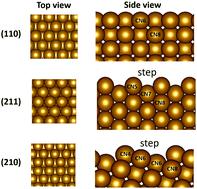当前位置:
X-MOL 学术
›
Phys. Chem. Chem. Phys.
›
论文详情
Our official English website, www.x-mol.net, welcomes your
feedback! (Note: you will need to create a separate account there.)
Theoretical understanding of the properties of stepped iron surfaces with van der Waals interaction corrections
Physical Chemistry Chemical Physics ( IF 2.9 ) Pub Date : 2021-1-15 , DOI: 10.1039/d0cp05977c Jessica Jein White 1, 2, 3, 4, 5 , Junxian Liu 1, 2, 3, 4, 5 , Jack Jon Hinsch 1, 2, 3, 4, 5 , Yun Wang 1, 2, 3, 4, 5
Physical Chemistry Chemical Physics ( IF 2.9 ) Pub Date : 2021-1-15 , DOI: 10.1039/d0cp05977c Jessica Jein White 1, 2, 3, 4, 5 , Junxian Liu 1, 2, 3, 4, 5 , Jack Jon Hinsch 1, 2, 3, 4, 5 , Yun Wang 1, 2, 3, 4, 5
Affiliation

|
The stepped surfaces in nanoscale zero-valent iron (nZVI) play an essential role for environmental application. However, there is still currently a deficiency in the atomic understanding of stepped surface properties due to the limitation of the computational methodology. In this study, stepped Fe(210) and (211) surfaces were theoretically investigated using density functional theory (DFT) computations in terms of the flat Fe(110) surface. Our results suggest that the consideration of van der Waals (vdW) interaction correction is beneficial for the DFT study on Fe-based systems. The DF-cx method is found to be the most promising vdW correction method. The DF-cx results reveal that the stepped Fe(210) and Fe(211) surfaces experience significant surface relaxation and abnormal trends in their work function. Their electronic properties and reactivities of the surface atoms are strongly affected by the Fe coordination numbers and the strong adsorption strengths of oxygen on the surfaces are dependent on both the coordination number of the adsorbed atoms and the geometry of the adsorption sites.
中文翻译:

范德华相互作用修正理论对阶梯铁表面特性的理论理解
纳米级零价铁(nZVI)的阶梯状表面对于环境应用起着至关重要的作用。然而,由于计算方法的局限性,目前在原子上对阶梯状表面特性的理解仍然缺乏。在这项研究中,理论上使用密度泛函理论(DFT)计算了平坦的Fe(110)表面,对阶梯状的Fe(210)和(211)表面进行了研究。我们的结果表明,考虑范德华(vdW)相互作用校正对基于铁的系统的DFT研究是有益的。发现DF-cx方法是最有前途的vdW校正方法。DF-cx结果表明,阶梯状的Fe(210)和Fe(211)表面经历了明显的表面弛豫和功函数异常趋势。
更新日期:2021-01-22
中文翻译:

范德华相互作用修正理论对阶梯铁表面特性的理论理解
纳米级零价铁(nZVI)的阶梯状表面对于环境应用起着至关重要的作用。然而,由于计算方法的局限性,目前在原子上对阶梯状表面特性的理解仍然缺乏。在这项研究中,理论上使用密度泛函理论(DFT)计算了平坦的Fe(110)表面,对阶梯状的Fe(210)和(211)表面进行了研究。我们的结果表明,考虑范德华(vdW)相互作用校正对基于铁的系统的DFT研究是有益的。发现DF-cx方法是最有前途的vdW校正方法。DF-cx结果表明,阶梯状的Fe(210)和Fe(211)表面经历了明显的表面弛豫和功函数异常趋势。











































 京公网安备 11010802027423号
京公网安备 11010802027423号